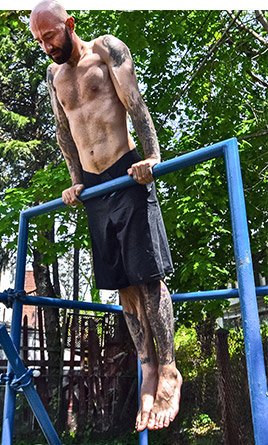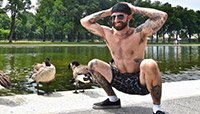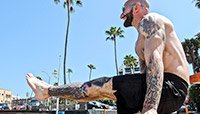Advanced calisthenics training is renowned for simultaneously developing total-body strength and coordination. High levels of fortitude and dexterity are required for feats like L-sits and muscle-ups—brute force simply isn't enough! To progress in the bodyweight training arena, multiple parts of the body are required to function in harmony.
Beginners often underestimate these moves due to the way advanced practitioners seem to perform them effortlessly, but they must be approached with respect and humility.
Tired of banging your head against the wall when it comes to mastering L-sits, muscle-ups, or pistols? Wondering when all those push-ups will blossom into the chest development of your dreams?
You're in the right place. Get ready to make a bodyweight breakthrough!
STICKING POINT 1
When you try to hold an L-sit, you get brutal muscle cramps in your quadriceps. You can't tell if the problem is lack of strength or lack of flexibility.
If this sounds familiar, rest assured that what you're experiencing is very common for people who are new to the L-sit. You're on the right track, thinking that strength and flexibility are both potential culprits here. In fact, it's most likely a combination of the two.
In order to perform a proper L-sit, you need to have adequate range of motion in your hamstrings, as well as ample strength in your quads and hip flexors. The tighter the muscles of your posterior chain become, the harder the muscles in front have to work in order to counterbalance them.
For now, I recommend that you regress to a bent-knee variation, and simultaneously focus on improving the range of motion in your hamstrings and lower back by practicing seated toe-touches.
Once you can hold a bent-knee L-sit for a full minute and comfortably perform a seated toe-touch, the full L-sit should be within your grasp.
L-Sit Tutorial
STICKING POINT 2
Muscle-ups on rings feel way harder than on a bar, or vice versa.
Regardless of the apparatus, the most challenging part of a muscle-up is the transition from the pulling phase into the pushing phase. When you perform a muscle-up on a bar, this transition can be especially difficult, because you have to move your body around the bar.
When you do a muscle-up on rings, you can move your torso in between the rings, which most people find easier.
Slow Non False Grip Muscle-up
While the rings are less difficult to get around during the transition phase, however, they are inherently unstable and therefore provide a unique challenge during both the pulling and pushing phases. I've known athletes who learned the muscle-up on rings first, and then struggled to learn the move on the bar, despite proficiency on the rings.
Conversely, I've known other athletes who learned the move on the bar first, and then struggled to achieve it on rings despite being able to do many reps on the bar.
So you see, it's not a clear-cut case of one being harder than the other. Either way, it's an advanced move that will take some trial and error to achieve.
Ultimately, I recommend getting comfortable with both if you want to keep your bodyweight skill set well-rounded.
Gymnastic Ring Fun!
STICKING POINT 3

You do lots of push-ups from all different angles and hand positions, but your chest isn't developing as much as you'd like.
Push-ups are my number one exercise for the chest, but if you aren't doing dips, I highly recommend adding them into your routine. Dips work your chest from a different angle than push-ups.
There are lots of dip variations to challenge anyone from the modest beginner to the most advanced athlete.
It's also important to remember that individual genetics play a major factor in the shape of your muscles. Your chest may tend to develop better in certain places than others, regardless of how you train.
Just as we all have differently shaped noses, eyes, and ears, we all have differently shaped pecs.
It's important to learn to love your body for what it is, instead of harping on perceived imperfections.
Progressive Calisthenics Tutorial Dips
Your chest might not ever look exactly like mine—and it shouldn't! Keep training hard, and you'll become a stronger version of you.
Focus on your training, and in time the aesthetics will fall into place.
STICKING POINT 4
You've been doing single-leg bench squats and other pistol-squat regressions, but you're hesitant to "upgrade" to unsupported squats because people say they're bad for the knees.
If you've been doing pistol variations for a while, you already have firsthand experience to draw from. If you're knees aren't hurting, then there's your answer. Don't let someone else's opinion override your own experience.
Having said that, I can say from my own experience that practicing pistols has kept my knees strong and supple. I've been doing pistols as part of my routine for over a decade, but I didn't try them until I'd already been working my legs for years.
Even then, I still needed to practice regressed versions of the move before I was ready for a full pistol. Any exercise is potentially dangerous if it is done with poor form or by a person who isn't ready for it, and the pistol is no exception. The move must be built up to gradually, and treated with the respect it deserves.
Pistol Squat Progression
As always, your training is what you make of it. If you're in a rush to get to advanced moves before you're ready, you may wind up hurting yourself. However, if you approach your training with reverence, you can progress gradually and enjoy the journey for a lifetime.
For more information, check out my book, Pushing the Limits!
Recommended For You

How To Perform A Full Squat And Reap The Benefits
Looking for a mobility goal that will have immediate carryover to your workouts and your life? Start with a full, resting bodyweight squat. The benefits are incredible!
7 Ways To Maximize Your Strength And Speed
Calisthenic training doesn't end with push-ups, pull-ups, and pistols. Advanced practitioners pack the Internet with showy moves that boggle the mind and set the bar ever higher. Here are 5 visual feats you should consider putting in your sights!


